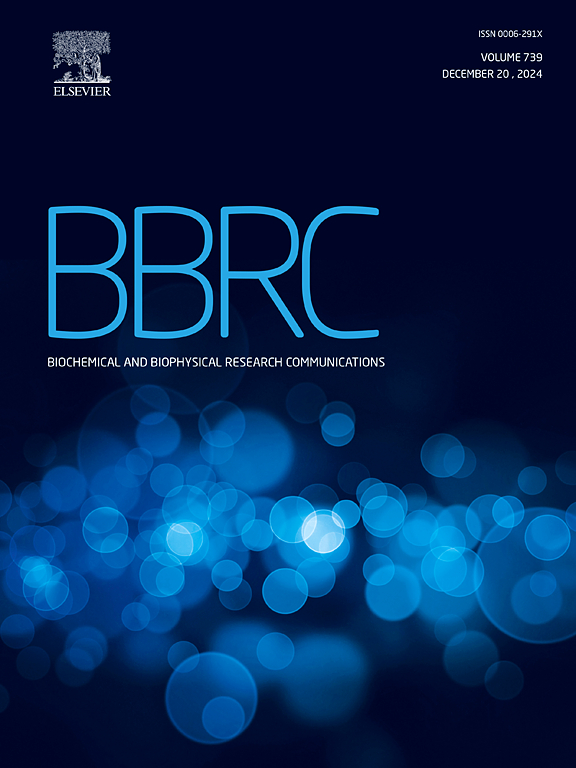结合生物信息学和实验验证,探讨地黄治疗多发性硬化症的作用机制和生物活性成分
IF 2.5
3区 生物学
Q3 BIOCHEMISTRY & MOLECULAR BIOLOGY
Biochemical and biophysical research communications
Pub Date : 2025-04-08
DOI:10.1016/j.bbrc.2025.151790
引用次数: 0
摘要
多发性硬化症(MS)是导致年轻人非创伤性残疾的主要原因,目前尚无有效的治疗方法。地黄(RR)是一种典型的中药,是MS患者常用的中药配方中最常见的草药。我们最近的研究表明,RR缓解了实验性MS模型的神经功能缺陷。然而,关于RR治疗MS的整体机制和生物活性成分的直接证据尚不清楚。本研究采用生物信息学与实验验证相结合的综合策略,分析RR的整体作用机制,鉴定其生物活性成分,并研究其在MS中的潜在靶点。首先,采用网络药理学方法构建“化合物-靶点-通路”网络,以多组分-多靶点模式提示RR对MS的作用,并预测棘球菊苷和毛蕊花苷为主要生物活性成分。基于GSE数据集的转录组学和单细胞RNA测序的生物信息学分析表明,小胶质细胞的氧化应激和炎症/免疫调节可能是紫雏菊苷和毛蕊花苷在MS病理中的重要机制。然后,体外实验验证了紫锥菊苷和毛茛苷具有抗炎和抗氧化作用,它们通过直接清除ONOO−和H2O2,并通过抑制NF-κ b介导的iNOS和NADPH氧化酶抑制小胶质源性ONOO−的产生。此外,分子对接显示毛蕊花苷与炎症相关靶点TGF-β和SMAD2具有较强的亲和力。这些发现为RR的临床应用提供了科学依据,并为MS药物开发带来了新的见解。本文章由计算机程序翻译,如有差异,请以英文原文为准。

Integrated bioinformatics and experimental verification to dissect the mechanisms and bioactive ingredients of Radix Rehmanniae in treating multiple sclerosis
Multiple sclerosis (MS), as a primary cause of nontraumatic disability in young adults, has no effective treatment yet. Radix Rehmanniae (RR), a typical Traditional Chinese Medicine (TCM), is commonly used in MS patients as a most frequent herbal item in TCM formulas. Our recent study demonstrated that RR alleviated neurological deficits in an experimental MS model. However, direct evidence regarding the holistic mechanisms and bioactive components of RR for MS remains unclear. In this study, we employed an integrative strategy combining bioinformatics and experimental validation to profile the holistic mechanisms of RR, identify its bioactive components, and investigate their potential targets in MS. First, a network pharmacology approach was used to construct a “compound-target-pathway” network, indicating the action of RR on MS in a multicomponent-multitarget mode, and predicting Echinacoside and Acteoside as the primary bioactive ingredients. Bioinformatics analyses of transcriptomics and single-cell RNA sequencing based on GSE datasets indicated that oxidative stress and inflammatory/immune regulation in microglia might serve as crucial mechanisms of Echinacoside and Acteoside in MS pathology. Then, in vitro assays validated that Echinacoside and Acteoside possessed anti-inflammatory and antioxidant properties by scavenging ONOO− and H2O2 directly, and suppressing microglia-derived ONOO− production through inhibition of NF-κB-mediated iNOS and NADPH oxidase. In addition, molecular docking showed strong affinities between Acteoside and inflammation-related targets TGF-β and SMAD2. These findings provide the scientific evidence for clinical application of RR and bring novel insights into MS drug development.
求助全文
通过发布文献求助,成功后即可免费获取论文全文。
去求助
来源期刊
CiteScore
6.10
自引率
0.00%
发文量
1400
审稿时长
14 days
期刊介绍:
Biochemical and Biophysical Research Communications is the premier international journal devoted to the very rapid dissemination of timely and significant experimental results in diverse fields of biological research. The development of the "Breakthroughs and Views" section brings the minireview format to the journal, and issues often contain collections of special interest manuscripts. BBRC is published weekly (52 issues/year).Research Areas now include: Biochemistry; biophysics; cell biology; developmental biology; immunology
; molecular biology; neurobiology; plant biology and proteomics

 求助内容:
求助内容: 应助结果提醒方式:
应助结果提醒方式:


